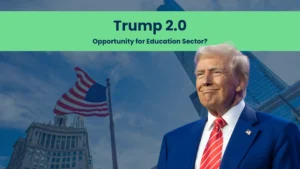India has a vast population of over 1.4 billion, with more than 50% of the demographic under the age of 25, presenting a massive opportunity for global educational companies. As of 2025, India is home to over 300 million students, and its $10+ billion EdTech sector continues to evolve with both local startups and global players competing for space.
But entering India isn’t easy, as it requires a deep understanding of the country’s diversity, regional disparity, cultural nuances, local alignment, regulatory frameworks, and long-term commitment.
Here’s what global Ed companies must understand before stepping into the Indian market:
1. India Is Not a Monolithic Market
With 28 states and 22 officially recognized languages, the education system is as diverse as the population. This means that a one-size-fits-all approach simply doesn’t work when it comes to designing or delivering educational content. What works in metro cities like Mumbai or Bengaluru may not resonate in Tier 2 or Tier 3 towns.
Approach:
- Recognize regional differences in language, culture, pedagogy
- Develop vernacular content that speaks to learners in their native languages
- Offer multi-language support, especially in states where multiple languages coexist
2. Curriculum alignment
India’s education is governed by multiple boards such as CBSE, ICSE, State Boards, and international curricula like IB/IGCSE. Your content must align with these varied curricula. To ensure relevance, applicability, and effectiveness, educational content and resources must be carefully aligned with the specific requirements of each board.
Approach:
- Mapping topics and competencies to the prescribed syllabus and grade-wise learning outcomes
- Adapting teaching strategies to suit board-specific learning styles
- Incorporating appropriate assessment formats and question styles as practiced by each curriculum
3. Pricing Sensitivity Is Critical
India is not only the world’s fastest-growing education market but also a price-sensitive market. While Indian families deeply value education and are often willing to make significant sacrifices for their children’s learning, cost remains a key barrier to entry, especially outside Tier 1 cities. Balancing quality with affordability, and design pricing strategies are key to building trust, accessibility, and long-term engagement.
Approach:
- Free trials, freemium models, or “pay-as-you-go” pricing can help build trust and adoption
- Provide subscription options, installment plans, or even pay-as-you-go models to widen accessibility
4. Mobile-First, Not Always Broadband-Ready
India is a mobile-first market, with over 600 million smartphone users, but not all devices are high-end or have stable internet connections. Many students access learning platforms on shared smartphones, which often have limited storage, low RAM, and restricted data plans. While broadband penetration is growing, it remains inconsistent, with mobile data serving as the primary mode of internet access for the majority of learners.
Approach:
- Optimize platforms for low-bandwidth environments as heavy apps with high-resolution content won’t perform well
- Ensure app-based solutions are lightweight, fast, and work offline or with limited data
- Focus on Android-first development, as it dominates the Indian smartphone market due to its affordability.
5. Trust and Brand Building are Paramount
In a market as vast and competitive as India, trust matters. With hundreds of EdTech platforms like BYJU’S, Vedantu, and Unacademy competing for attention, parents and students not only seek cutting-edge tools or impressive features, but also credibility, reliability, and evidence that your solution provides tangible value.
Approach:
- Partner with local education influencers, parenting bloggers, or YouTube educators to create authentic, relatable content
- Showcase success stories, especially from students who’ve improved academic performance or secured competitive exam success
- Collaborate with teachers, tutors, or school leaders who already have credibility in the community
5. Understanding the Regulatory Landscape
The Indian government, including entities such as the Ministry of Education, the University Grants Commission (UGC), and AICTE, has increased its efforts to regulate digital education. This heightened focus extends to areas such as safeguarding student data privacy, ensuring ethical advertising practices, improving learning outcomes, and promoting affordability. Global educational companies entering the Indian market must proactively prepare for compliance, transparency, and responsible operations.
Approach:
- Keep track of guidelines from regulatory bodies like the Ministry of Education and the University Grants Commission (UGC)
- Avoid making exaggerated claims about outcomes, as aggressive marketing tactics are under regulatory scrutiny
- Consider forming partnerships with established schools or institutions to facilitate entry into the market and build credibility
6. Tapping into Competitive Exams is Strategic
In India, competitive exams hold significant importance as they serve as pivotal milestones in shaping individuals’ careers. With a wide range of exams such as JEE, NEET, CAT, UPSC, and SSC, millions of students diligently prepare for these exams each year, with some initiating their preparations as early as Grade 6. When venturing into the Indian education market, it is crucial for a global player to understand and tap into the country’s deeply entrenched culture of competitive exams.
Approach:
- Offer high-quality practice banks, adaptive assessments, mock exams, and performance analytics aligned to local competitive exam formats
- Go beyond curriculum coaching and focus on skill building like critical thinking, reasoning, reading comprehension, and time management
- Use adaptive learning technology to create tailored learning paths based on student strengths, weaknesses, and exam timelines
- Design preparation materials for for globally recognized exams such as SAT, GMAT, IELTS, or GRE
7. Support and Communication Matter
Unlike in some Western markets where students or adult learners drive their own learning journeys, Indian education is often parent-driven, especially in the K–12 segment, where children may not be directly involved in choosing their learning tools or platforms. This dynamic makes it essential for global education players to proactively engage with parents to bolster adoption rates, improve retention, and foster lasting brand loyalty.
Approach:
- Multilingual Customer Support to help parents understand the platform more comfortably in their native languages
- Regular Parent Communication and Transparent Reporting to enable parents witness measurable academic outcomes and progress of their child
- Building lasting trust through clarity, consistency, and responsiveness in terms of your product, pricing, refund, cancellation, outcome, and feedback
Wrapping Up
India’s education market is vast, vibrant, and full of opportunities, but it’s also nuanced, complex, and fiercely competitive. For global players, success here doesn’t come from simply translating a platform or replicating a Western model. Breaking into this market requires a deep understanding of Indian languages, cultural sensitivity, strategic patience, relevant partnerships with local institutions, educators, and influencers who understand the terrain far better than any outsider.
Ready to Enter India?
Whether you’re evaluating market potential, seeking local partnerships, or preparing your platform for regional launch, India Market Entry (IME) can serve as your trusted on-ground partner. With deep expertise in education localization, school partnerships, regulatory navigation, and parent engagement strategies, IME helps global education institutions enter and scale in India with confidence.
Start your India journey with IME: Explore our services at IndiaMarketEntry.com





